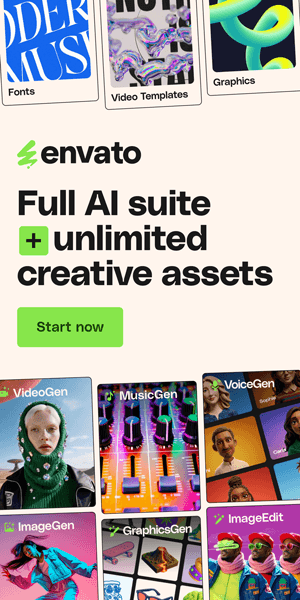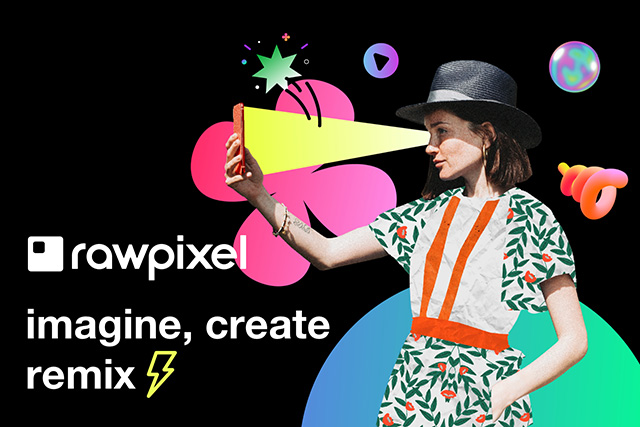Unleash the Bold: A Guide to Maximalism in Graphic Design
Introduction
Maximalism in graphic design is more than just throwing everything at the wall and hoping it sticks. It's a vibrant and expressive design movement that utilizes bold colors, patterns, textures, and elements to create visually striking and engaging compositions.
In this post, we'll provide an all-encompassing rundown of maximalism in graphic design, including:
Whether you're a seasoned designer or just starting out, this guide will help you understand and appreciate the power of maximalism in graphic design.
What is Maximalism in Graphic Design
Maximalism in graphic design stands in stark contrast to its minimalist counterpart. It embraces abundance, vibrancy, and an explosion of creative elements, pushing the boundaries of traditional design principles.
Here are its core principles:
Express their unique personality and brand story in a way that is both memorable and impactful. Imagine a brand identity that truly reflects its core values and resonates with its target audience on a deeper level.
Capture attention and stand out from the competition in a crowded marketplace. In an oversaturated market, standing out is crucial. Maximalism's bold and unconventional approach can help brands grab attention and leave a lasting impression.
Connect with audiences on an emotional level and create a lasting impression. Maximalist designs can be evocative and immersive, transporting viewers to a specific mood or feeling. This emotional connection can be a powerful tool for building brand loyalty and trust.
However, it's important to wield maximalism strategically. Used effectively, it can be a powerful design tool. Used haphazardly, it can lead to visual clutter and overwhelm the viewer. Just like any design style, balance and intentionality are key to achieving success.
The History of Maximalism
While the term "maximalism" itself is a recent invention, its roots can be traced back centuries in the art and design world, showcasing its enduring appeal. Let's delve into its fascinating journey:
Early Seeds: Even in ancient times, civilizations like the Egyptians and Byzantines embraced intricate details, rich colors, and layered ornamentation in their art and architecture. These elements, characterized by an abundance of visual elements, laid the foundation for the maximalist approach to aesthetics.
The Rise of Decorative Movements: The 19th century saw the flourishing of various movements that celebrated ornamental details and vibrant palettes, directly influencing the development of maximalism. Art Nouveau, with its flowing lines, organic motifs, and bold colors, and the Arts and Crafts movement, emphasizing handcrafted objects and intricate details, are prime examples. These movements embraced a love for ornament and pattern, rejecting the emerging trends of minimalism and seeking to elevate everyday objects into works of art.
20th Century Exploration: The 20th century witnessed a shift towards modernism and minimalism, emphasizing simplicity and clean lines. This period saw a decline in the popularity of maximalist aesthetics, as functionality and streamlined design took center stage. However, pockets of maximalist expression persisted, like the Memphis Group in the 1980s. Known for its playful and unconventional furniture designs featuring bold colors, geometric patterns, and a disregard for traditional design rules, the Memphis Group challenged the dominance of minimalism and offered a refreshing counterpoint.
Contemporary Expression: In recent years, maximalism has experienced a resurgence in various design fields, from fashion and interiors to graphic design. This resurgence can be attributed to several factors:
A desire for individuality and self-expression in a world increasingly dominated by digital minimalism. As the digital landscape becomes more streamlined and homogenized, individuals seek to express their unique personalities and cultural backgrounds through their choices in design. Maximalism, with its embrace of diverse elements and patterns, allows for a more personal and expressive approach.
The abundance of visual information in the digital age, leading some to seek out designs that offer a more stimulating and immersive experience. In a world bombarded with constant visual stimuli, maximalist designs can stand out with their bold use of color, pattern, and texture, offering a visually engaging and captivating experience.
A growing appreciation for diversity and cultural influences, reflected in the incorporation of various patterns, textures, and styles into maximalist designs. As societies become more multicultural and interconnected, there is a greater appreciation for the richness and diversity of global aesthetics. Maximalism, by embracing a wider range of influences and cultural references, reflects this growing appreciation for the beauty and value of diverse design traditions.
Maximalism's story continues to evolve, offering a dynamic and ever-evolving approach to visual expression. It serves as a reminder that design can be as much about personal expression and cultural exploration as it is about functionality and clean lines.
Terms to Know
Maximalist design thrives on a unique vocabulary built upon the interplay of various elements and techniques. Here are some key terms to enhance your understanding of this vibrant design style:
Layering: Imagine a rich tapestry woven from diverse design elements. Layering refers to the strategic superimposition of various visual components, such as colors, patterns, textures, and typographic styles, on top of each other. This deliberate layering creates depth and dimension, adding a captivating layer of visual interest to the overall composition.
Pattern clashing: A hallmark of maximalism, pattern clashing breaks away from conventional design principles by embracing the intentional use of seemingly incongruous patterns together. This can involve mixing patterns of different scales, colors, and styles, creating a visually dynamic and unexpected effect. However, achieving successful pattern clashing requires a skilled hand and a keen eye for balance. Striking the right balance ensures the patterns complement each other, avoiding visual chaos and overwhelming the viewer.
Eclecticism: Maximalism celebrates the richness and diversity found in the world around us. Eclecticism embodies this spirit by incorporating a harmonious blend of diverse styles, influences, and elements from various periods and cultures. This approach allows designers to break free from the constraints of a single style, drawing inspiration from a wider spectrum of sources to create unique and personalized compositions that reflect their individual voice or the brand's identity.
Focal point: While maximalist designs may appear brimming with visual elements, maintaining a clear focal point is crucial for effective communication. This focal point acts as a guiding star, drawing the viewer's eye and directing them through the composition. Designers can utilize various techniques to establish a focal point, such as employing contrasting colors, employing bold typography, or strategically placing key elements.
Negative space: Even amidst the abundance of elements that define maximalism, negative space remains a vital design consideration. It refers to the empty areas surrounding design elements, serving as a canvas that allows the various components to breathe and preventing the composition from becoming visually overwhelming. Effective utilization of negative space ensures a balanced and visually engaging design experience.
By familiarizing yourself with these key terms, you'll gain a deeper understanding of the language of maximalist design, empowering you to appreciate existing works and potentially create your own captivating maximalist compositions.
The Pros and Cons of Maximalism
Maximalism, with its bold approach and vibrant energy, offers a unique set of advantages and disadvantages for designers to consider. Let's delve deeper into both sides of the coin:
Pros:
Visually arresting: Maximalism excels at grabbing attention. The explosion of colors, patterns, and textures creates a visually stimulating experience that cuts through the noise in a world often dominated by minimalist aesthetics. This can be particularly beneficial for brands and businesses seeking to make a lasting impression and differentiate themselves from the competition. Imagine a restaurant brochure bursting with colorful food photography, vibrant illustrations, and playful typography, instantly transporting the viewer to a lively and inviting dining experience.
Uniqueness and expression: Maximalism encourages designers to break free from the conventional and express their creative vision with unrestrained freedom. This freedom allows for the creation of truly unique and personalized designs that reflect the individual's style or a brand's unique personality. Think of a band poster showcasing a captivating collage of photographs, hand-drawn illustrations, and bold typography, capturing the essence of the band's musical style and artistic identity.
Emotional connection: Maximalist designs can be highly evocative and emotive, transporting viewers to a specific mood or feeling. This ability to connect with audiences on an emotional level can be a powerful tool for storytelling and brand building. Imagine a website promoting a travel agency, featuring a captivating blend of photographs capturing breathtaking landscapes, cultural landmarks, and diverse people, evoking a sense of wanderlust and adventure, inspiring users to embark on their own journeys.
Richness and diversity: Maximalism embraces a global perspective, welcoming influences from various cultures and styles. This allows for the creation of designs that are rich in cultural references and celebrate the interconnectedness of our world. Picture a fashion brand's campaign featuring models adorned in a diverse array of clothing, drawing inspiration from various cultural aesthetics, celebrating the beauty and individuality found in different parts of the globe.
Cons:
Risk of clutter: If not handled meticulously, maximalism can easily devolve into visual clutter, overwhelming the viewer and hindering the communication of the intended message. Maintaining balance and hierarchy is crucial to ensure the design remains visually appealing and effective. Imagine a website homepage bombarded with conflicting colors, clashing patterns, and overwhelming information, making it difficult for users to navigate and find the desired information.
Accessibility concerns: The complex nature of maximalist designs can pose challenges for individuals with visual impairments or cognitive disabilities. Ensuring sufficient contrast, clear hierarchy, and alternative text descriptions for visual elements is essential to create designs that are inclusive and accessible to everyone. For instance, using high-contrast color combinations for text and backgrounds, employing clear and concise language, and providing detailed descriptions of important images can ensure everyone can understand and engage with the design.
Production challenges: Implementing maximalist designs can be more time-consuming and resource-intensive compared to minimalist approaches. This is due to the need for careful planning, selection, and arrangement of numerous design elements. Imagine creating a magazine layout featuring a multitude of photographs, illustrations, and text elements, each requiring meticulous selection, placement, and adjustment to achieve a cohesive and visually balanced composition.
Subjectivity: Maximalist designs, due to their inherent boldness and unconventional nature, are more subjective and prone to individual interpretation compared to minimalist designs. This can pose challenges in ensuring the design resonates with the target audience and effectively conveys the intended message. For instance, a website design employing a clashing color palette and unconventional typography might evoke a sense of excitement and energy for some viewers, while others might find it jarring and difficult to navigate.
Ultimately, the decision to utilize maximalism is a strategic one. By weighing the potential benefits against the drawbacks and ensuring careful execution, designers can leverage this unique style to create impactful and engaging visual experiences that resonate with their target audience and achieve their design objectives.
Examples of Maximalism in Graphic Design
Maximalism's vibrant energy and bold approach can be found across various applications in graphic design, breathing life into branding, packaging, web design, and even print design. Here are a few inspiring examples that showcase the versatility and impact of this dynamic style:
Branding:
La DoubleJ: This Italian clothing brand embraces maximalism in its entirety. Their website and social media channels are a kaleidoscope of bold colors, playful patterns, and eclectic typography, reflecting the brand's vibrant and quirky personality. Imagine scrolling through their Instagram feed, encountering a whimsical collage featuring a model adorned in a floral dress, set against a backdrop of geometric patterns and overlaid with playful text, instantly transporting you into their world of joyful self-expression.


Packaging:
Fortnum & Mason: This luxury department store's tea packaging exemplifies sophisticated maximalism. The intricate floral patterns, rich colors, and gold foil details create a visually stunning and luxurious experience. Picture a box of their tea adorned with a captivating illustration of blooming flowers, rendered in a rich palette of jewel tones and accented with gold foil, immediately conveying a sense of elegance and premium quality.


Web Design:
The Webster: This online luxury fashion retailer's website showcases a masterfully executed maximalist approach. The website features high-quality product photography, bold typography, and carefully curated video content, all woven together seamlessly to create a visually immersive and engaging shopping experience. Imagine browsing their website, encountering a dynamic layout featuring a captivating product image layered with bold, descriptive text, alongside a short video showcasing the garment in motion, creating a multi-sensory experience that entices you to explore further.

Print Design:
Wes Anderson Posters: Film director Wes Anderson's movie posters are renowned for their use of maximalism. They feature a meticulous blend of symmetrical layouts, vibrant color palettes, intricate details, and quirky typography, capturing the essence of his unique cinematic style. Picture the poster for "The Grand Budapest Hotel," a meticulously crafted composition featuring the film's main characters standing in front of the iconic pink hotel, surrounded by whimsical details like symmetrical windows, quirky signage, and a vibrant color palette, instantly transporting you into the director's imaginative world.

Beyond these examples, the world of maximalist graphic design is brimming with creativity. From the playful illustrations adorning children's book covers to the bold graphics used in music festival posters, maximalism's influence can be felt across various design disciplines. By exploring these diverse applications, you'll discover a treasure trove of inspiration showcasing the power of this dynamic style to capture attention, tell stories, and evoke emotions through the bold and expressive use of visual elements.
Tips and Reminders for Using Maximalism
Maximalism's vibrant energy and abundance of elements can create captivating designs, but navigating this style effectively requires a nuanced approach. Here are some practical tips and essential reminders to keep in mind when incorporating elements of maximalism into your design projects:
Embrace curation, not chaos: While maximalism celebrates the "more is more" philosophy, it's crucial to avoid simply throwing everything at the wall and hoping it sticks. Instead, curate your design elements meticulously.
Focus on intentionality: Select colors, patterns, and textures that complement and cohere with each other, creating a visually unified and harmonious composition. Each element should contribute to the overall story you're trying to tell or the message you're aiming to convey.
Maintain a clear hierarchy of information: Even amidst an abundance of elements, guiding the viewer's eye remains paramount. Establish a clear hierarchy of information using contrast, size, and placement. This ensures your primary message takes center stage and doesn't get lost in the visual symphony.
Utilize visual hierarchy tools: Employ techniques like larger fonts for headlines, bolder colors for important information, and strategic placement to guide the viewer's visual journey through your design.
Negative space: your silent partner: While maximalism thrives on a multitude of elements, negative space isn't the enemy. Utilize it strategically to balance the composition and prevent your design from becoming visually overwhelming. Think of it as the breathing room that allows the other design elements to stand out and shine.
Strike the right balance: Aim for a harmonious interplay between negative space and design elements. Too much negative space can leave your design feeling sparse, while neglecting it entirely can lead to visual clutter. Finding the sweet spot is key to achieving a visually pleasing and engaging composition.
Typography matters, choose wisely: Don't let your carefully crafted visual symphony be disrupted by illegible text. Select typefaces that complement the overall design aesthetic while prioritizing clarity and legibility. Avoid overly decorative fonts, especially for large blocks of text, as they can hinder readability and diminish the effectiveness of your message.
Consider context and audience: When choosing typefaces, remember context and audience. Opt for fonts that are appropriate for the intended purpose and resonate with your target audience. For instance, a playful and whimsical font might be suitable for a children's book illustration, while a more formal and classic typeface might be better suited for a legal document.
Start small and iterate: If you're new to maximalism, don't be intimidated by the abundance of elements. Begin by incorporating subtle maximalist touches into your existing designs. This could involve introducing a bold pattern as an accent, using a vibrant color for a call to action, or experimenting with a layering technique for a specific section. Gradually increase the complexity as you gain confidence and refine your approach.
Remember, balance is key: The success of any maximalist design hinges on achieving balance. This doesn't mean perfect symmetry, but rather a harmonious interplay of elements that creates a visually pleasing and engaging experience. Ensure your design elements, while diverse and abundant, coexist in a way that feels cohesive and avoids overwhelming the viewer.
By following these tips and keeping the importance of curation, hierarchy, negative space, typography, context, and iteration in mind, you can harness the power of maximalism to create bold, expressive, and captivating designs that stand out from the crowd and effectively communicate your message.
Conclusion
Maximalism in graphic design offers a vibrant and expressive alternative to minimalist aesthetics. It celebrates an abundance of colors, patterns, textures, and elements, aiming to tell stories, evoke emotions, and capture attention. While potentially more challenging to execute than minimalism, when used strategically, maximalism can create impactful and memorable designs that resonate with audiences.
This guide has explored the core principles of maximalism, its history, key terms, and the advantages and disadvantages associated with this design style. We've also showcased inspiring examples and provided practical tips to help you incorporate maximalist elements into your own design projects.
Remember, maximalism isn't about chaos; it's about intentionality and creating a harmonious interplay of elements. So, embrace your creativity, experiment, and unleash the bold potential of maximalism in your next design project!
Additional resources
Tags
Subscribe
Join the Advise Graphics community and get exclusive design resources, tips, and updates delivered straight to your inbox.
Quick links
Copyright
© 2025 Advise Graphics. All rights reserved.
Cop© 2025 Advise Graphics. All rights reserved.











